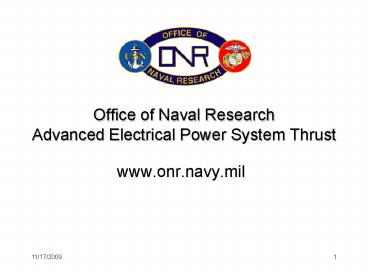Office of Naval Research Advanced Electrical Power System Thrust - PowerPoint PPT Presentation
1 / 18
Title:
Office of Naval Research Advanced Electrical Power System Thrust
Description:
Pulse Width Modulation, PWM, converters is the major difference between past and ... CVN21 EMALS DDX Electric Submarine / Littoral Combatant ... – PowerPoint PPT presentation
Number of Views:36
Avg rating:3.0/5.0
Title: Office of Naval Research Advanced Electrical Power System Thrust
1
Office of Naval Research Advanced Electrical
Power System Thrust
- www.onr.navy.mil
2
The Enablers
- Pulse Width Modulation, PWM, converters is the
major difference between past and present systems - Solid-state switches
- Digital controls
- Programmable
- Past systems were synchronous 60hz generation
and loads - Tomorrow's systems will be asynchronous
generation working their optimum and loads at
their optimum - Ships will be design to meet the functional
requirements of a mission with the minimum
numbers of boxes -- instead of a box for each
mission function, as is the case today.
3
Power Design History
- Past, control and power circuit were unique and
unchanging, hardwired. - Today, with Digital Control PEBBs Power
Electronic Building Blocks - For a given set of PEBBs, control and
configuration can be varied during design process
to produce different products. - However, the final product is unique and
unchanging with a fixed control algorithm - Tomorrow, with Digital Control Networks
- For a configuration of PEBBs, control can be
varied in the field to produce many different
system functions. - Topology will be dependent on the control
implemented and the time dependant system
coupling. - Models are Essential design, onboard,
reference, system simulator/controller
4
New Technology Drivers
- Power Density
- Energy Density
- System Efficiency
- Control
- Conversion Steps
- Number of Phase Legs
- Reconfiguration
- Voltage
- Current
- Frequency
- Pulse forming networks require charging
circuits ranging from 10kV to 40kV. - Pulse forming discharge circuits can require up
to 100kV switching. - Modulator circuits require 10kV to 50kV for
input voltages and output voltages ranging from
50kV to 1MV.
5
Metrics
6
Achieving the All Electric Force Ship
Electrical Power Systems
7
The Changing Role of Simulation
- Today, simulation is used for evaluation.
- Simulation programs require detailed design
information - Circuit parameters are entered before simulation
begins. - Variations in design can be analyzed
- Tomorrow, simulation will become part of the
design process.
The Model Will Be The Specification
8
The Design Process
FINISH
Prof. Abd A. Arkadan Marquette University
Yes
Requirements
Performance
START
Match?
No
Modify
Analysis
Synthesis
Prototype Device
9
The Design Process Direct Problem
FINISH
Prof. Abd A. Arkadan Marquette University
Yes
Requirements
Performance
START
Match?
No
Modify
Analysis
Synthesis
Prototype Device
10
The Design Process Inverse Problem
FINISH
Prof. Abd A. Arkadan Marquette University
Yes
Requirements
Performance
START
Match?
No
Modify
Analysis
Synthesis
Prototype Device
11
Characteristics of Inverse Direct Problems
Prof. Abd A. Arkadan Marquette University
- Direct problem
- It is well posed
- existence a solution exists
- unique one solution
- stability solution depends continuously on data
- Inverse Problem
- usually less is known about the problem
- ill posed
12
The Model Is The Specification
- Types of Models
- Requirement Models (synthesis)
- Product Models (analysis)
- There may be many Product Models for a given
Requirement Model
13
The Design Cycle
Customer Designer
Performance, Life, Cost
Requirements
Products
Supplier Designer
Design With Known Products
14
Concurrent Design
System
Sub-System
15
Concurrent Design with Many Unknowns and Many
Design Levels, System of Systems
N-Dimensional Design Space Electrical, Thermal,
Mechanical, and Chemical
16
Research Problem
- Design based on potential elements
- Potential elements
- Set of potential system designs
- Set of potential future requirements
- Extrapolation from known elements, system design
processes, and requirements
Product models MUST Be Physics Based
17
Research Dilemma
- A real system baseline is critical for power
research - Cannot afford to build real systems for research
- Real systems under development are not
technically or politically sufficient for a
research baseline - Number of statically significant experiments for
the study of system of systems is for practical
purposes infinite.
18
Validation and Emulation
- Can not build the whole system, however
- With physics based models, one will be able to
assert the reality of future systems based on
known physics. - Risk is a direct function of the unknown physics
quantification of risk. - Build measurable portions of the future system to
accept or reject the hypothesis of unknown
physics. - Build a little and learn a lot.
- Digital Power Laboratory is Essential































